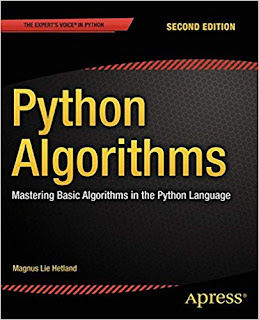Python Algorithms 2nd Edition: Mastering Basic Algorithms in the Python Language
Download
Introduction
What’s All This, Then?
This is a book about algorithmic problem solving for Python programmers. Just like books on, say, object-oriented
patterns, the problems it deals with are of a general nature—as are the solutions. For an algorist, there is more to
the job than simply implementing or executing an existing algorithm, however. You are expected to come up with
new algorithms—new general solutions to hitherto unseen, general problems. In this book, you are going to learn
principles for constructing such solutions.
This is not your typical algorithm book, though. Most of the authoritative books on the subject (such as Knuth’s
classics or the industry-standard textbook by Cormen et al.) have a heavy formal and theoretical slant, even though
some of them (such as the one by Kleinberg and Tardos) lean more in the direction of readability. Instead of trying
to replace any of these excellent books, I’d like to supplement them. Building on my experience from teaching
algorithms, I try to explain as clearly as possible how the algorithms work and what common principles underlie
many of them. For a programmer, these explanations are probably enough. Chances are you’ll be able to understand
why the algorithms are correct and how to adapt them to new problems you may come to face. If, however, you need
the full depth of the more formalistic and encyclopedic textbooks, I hope the foundation you get in this book will help
you understand the theorems and proofs you encounter there
There is another genre of algorithm books as well: the “(Data Structures and) Algorithms in blank” kind, where
the blank is the author’s favorite programming language. There are quite a few of these (especially for blank = Java,
it seems), but many of them focus on relatively basic data structures, to the detriment of the meatier stuff. This is
understandable if the book is designed to be used in a basic course on data structures, for example, but for a Python
programmer, learning about singly and doubly linked lists may not be all that exciting (although you will hear a bit
about those in the next chapter). And even though techniques such as hashing are highly important, you get hash
tables for free in the form of Python dictionaries; there’s no need to implement them from scratch. Instead, I focus on
more high-level algorithms. Many important concepts that are available as black-box implementations either in the
Python language itself or in the standard library (such as sorting, searching, and hashing) are explained more briefly,
in special “Black Box” sidebars throughout the text.
There is, of course, another factor that separates this book from those in the “Algorithms in Java/C/C++/C#”
genre, namely, that the blank is Python. This places the book one step closer to the language-independent books
(such as those by Knuth,3
Cormen et al., and Kleinberg and Tardos, for example), which often use pseudocode,
the kind of fake programming language that is designed to be readable rather than executable. One of Python’s
distinguishing features is its readability; it is, more or less, executable pseudocode. Even if you’ve never programmed
in Python, you could probably decipher the meaning of most basic Python programs. The code in this book is
designed to be readable exactly in this fashion—you need not be a Python expert to understand the examples
(although you might need to look up some built-in functions and the like). And if you want to pretend the examples
are actually pseudocode, feel free to do so
What the book is about:
• Algorithm analysis, with a focus on asymptotic running time
• Basic principles of algorithm design
• How to represent commonly used data structures in Python
• How to implement well-known algorithms in Python
What the book covers only briefly or partially:
• Algorithms that are directly available in Python, either as part of the language or via the
standard library
• Thorough and deep formalism (although the book has its share of proofs and proof-like
explanations)
What the book isn’t about:
• Numerical or number-theoretical algorithms (except for some floating-point hints in Chapter 2)
• Parallel algorithms and multicore programming
As you can see, “implementing things in Python” is just part of the picture. The design principles and theoretical
foundations are included in the hope that they’ll help you design your own algorithms and data structures

